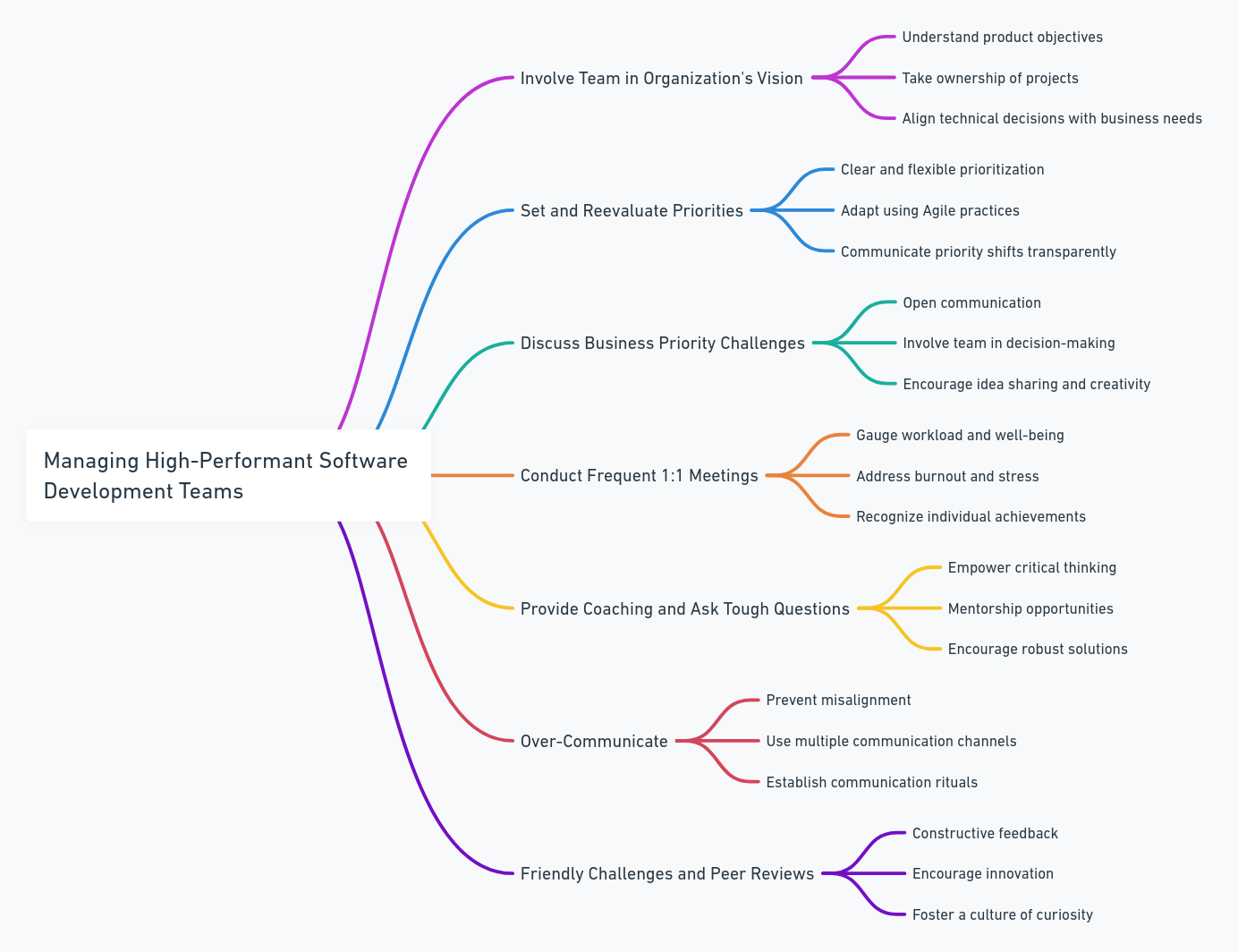Effectively managing a high-performing software development team is an ongoing challenge that requires strategic alignment, clear communication, and an understanding of both technical intricacies and human dynamics. The following principles highlight key management techniques, supported by research and real-world software development examples.
1. Involve the Team in the Organization's Vision and Product Goals
Connecting your software engineering team to the organization's broader mission and product objectives is crucial. Developers who understand the "why" behind their work are more likely to take ownership of their projects and make technical decisions that align with business needs.
For example, if your company is developing a real-time recommendation engine for a social media feed, explaining the importance of latency reduction for customer retention can help the team prioritize efficient algorithms. When engineers know that shaving milliseconds off response times could translate to millions in revenue, they are more driven to optimize performance.
Research published in The Journal of Strategic Information Systems shows that when teams are aware of their contributions to organizational success, their engagement and output improve significantly [1]. Practical ways to foster this understanding include product vision meetings and customer impact presentations.
2. Set and Continuously Reevaluate Priorities
In the world of software development, project timelines can easily be disrupted by increased scope, underestimated effort, or unforeseen events like a critical bug. Clear and flexible prioritization helps teams navigate these changes effectively.
Imagine a scenario where a team is focused on delivering a new analytics dashboard but is suddenly faced with a significant security vulnerability in a core service. It becomes necessary to shift focus immediately. By adopting Agile practices, such as regular backlog grooming and sprint planning sessions, teams can adapt to changing priorities in a structured way.
The Agile Manifesto emphasizes responding to change as a key principle, which empirical studies have shown leads to better performance in volatile environments [2]. Communicating priority shifts transparently ensures that developers understand the "why" behind these changes, keeping them motivated and engaged.
3. Discuss Business Priority Challenges Openly
Early in my career, I often tried to protect my team from the stress of shifting business priorities, only to find that this approach led to confusion and reduced morale. By being open about challenges and involving the team in decision-making, I discovered a more effective approach.
For example, if a project needs to be put on hold to address a high-priority client request, explaining the strategic importance of the client can make a big difference. By being transparent with the team, they can also propose creative ways to preserve progress on the original project, such as documenting the current state and leaving helpful comments for a seamless resumption later. Teams that feel safe to share concerns and ideas without fear of negative consequences are more adaptable and innovative. Leaders should therefore encourage discussions about business challenges and listen actively to team suggestions.
4. Conduct Frequent 1:1 Meetings to Gauge Workload and Well-Being
Frequent one-on-one meetings are an essential part of managing a software development team. These sessions offer an opportunity to understand each team member's workload, identify potential burnout risks, and discuss career aspirations.
For instance, if a developer mentions that a specific component of an event-driven system is causing them stress, a manager could explore options such as bringing in a subject matter expert or redistributing tasks. Additionally, these meetings can uncover non-technical challenges, like difficulties with remote work setups, that may be affecting performance.
The IEEE Software Journal reports that managers who engage in regular check-ins are more effective in supporting their teams and addressing issues before they escalate [3]. These conversations also offer a chance to recognize individual achievements, which can significantly boost morale.
5. Provide Coaching and Ask Tough Questions
Coaching is about more than solving immediate technical problems; it's about empowering developers to think critically and grow. One way to achieve this is by asking tough, thought-provoking questions during design and code review sessions.
For example, when discussing a proposed API integration for a new feature, ask, "How does this design handle edge cases, like network failures?" or "What is our rollback strategy if things go wrong?" These questions push engineers to think beyond the happy path and consider the robustness and resilience of their solutions. Managers who challenge their teams to think deeply and independently see better long-term outcomes. In addition, offering mentorship opportunities, such as pairing junior and senior developers, can accelerate learning and improve team dynamics.
6. Over-Communicate to Prevent Misalignment
In software development, communication breakdowns can lead to costly mistakes, especially in distributed teams or when working on complex, interdependent systems. Over-communication can help prevent these issues.
For instance, if a backend service update requires changes to a frontend application, make sure to communicate the details through multiple channels, like Slack, email, and in team meetings. Documenting the change in a shared knowledge base ensures that everyone has access to the information.
Research in Information and Software Technology has shown that clear and frequent communication reduces the risk of misalignment and helps teams avoid accruing technical debt [4]. Establishing rituals like daily stand-ups and weekly syncs can further enhance clarity and collaboration.
7. Friendly Challenges and Peer Reviews
Creating a culture where team members feel comfortable challenging each other's ideas constructively is essential for innovation. Code reviews and architecture discussions should be opportunities for learning, not just quality assurance.
For example, during a review of a new caching strategy for a high-traffic service, team members might debate the trade-offs between cache hit rate and memory usage. This friendly challenge can lead to a more refined and optimized solution.
Empirical studies have found that teams engaging in respectful peer reviews produce higher-quality code and more robust architectures [4]. To foster this culture, managers should set the tone by encouraging curiosity and celebrating well-reasoned critiques.
References
-
The Journal of Strategic Information Systems: https://link.springer.com/article/10.1007/s10796-016-9632-3
-
Agile Manifesto: https://agilemanifesto.org/
-
O. Springer, J. Miler and M. Wróbel, "Strategies for Dealing With Software Product Management Challenges," in IEEE Access, vol. 11, pp. 55797-55813, 2023, doi: 10.1109/ACCESS.2023.3282605.
-
Delizonna, L. (2017). High-performing teams need psychological safety. Here’s how to create it. Harvard Business Review, 8, 1-5.


